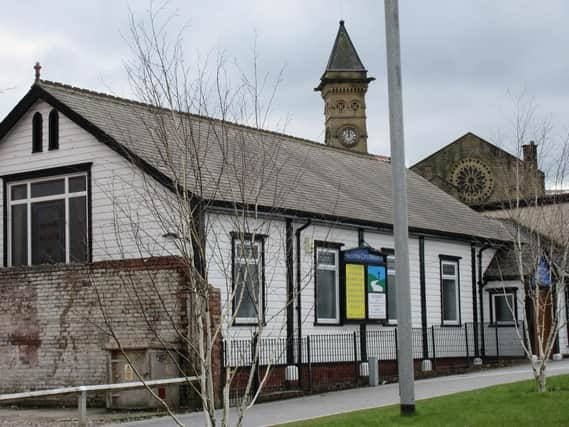Preston landmark under threat


On Corporation Street, in Preston, stands a wooden structure which is home these days to the Preston City Mission. To many people it is an iconic structure which has stood its ground since the dawn of the 20th Century. Corporation Street has seen changes down the years since the canal terminated close to the Public Hall, including the arrival of the Ringway which split it into two. Nonetheless, its days appear numbered now after plans were unveiled late last year for an eight-storey apartment block.The origins of this missionary church date back to 1885 when Mrs Brown, widow of the late Canon Brown, vicar of the Holy Trinity Church, and sister-in-law of Dr Robert Charles Brown, the Preston surgeon, began a regular Sunday service on the platform of Preston Railway Station. The gatherings were intended to promote the spiritual, moral, social and physical welfare of the railway servants. With many railway workers obliged to work on the Sabbath it gave them an opportunity to hear the Gospel.Mrs. Brown was encouraged by the response and, within a year, the Railway Mission had become affiliated to the ‘Railway Servants’ Mission’ – a nationwide organisation. In those late Victorian days it was a career full of hazards, with many a railway employee, or indeed traveller, being involved in accidents and incidents. The mission organisers often being called upon when tragedy and trauma struck to comfort those in need. Within a decade the mission on the platform was providing services on Sunday, prayers on a Wednesday and education for youngsters on a Friday. Plans were drawn up to erect a permanent home on Pitt Street with more than £100 raised for the purpose. Unfortunately, railway track improvements on Pitt Street scuppered that plan.However, the Railway Mission saw its hopes realised in March 1900 when a gathering took place in Corporation Street for the laying of the four corner stones of their new headquarters. It was to cost £670 (equivalent to £80,000 today) and Messrs. Topping Brothers of Preston had acquired the contract for building the wood structure on brick foundations. The completed building on a site provided by the railway company to measure 55ft long x 30ft wide and capable of accommodating 250 worshippers. The first stone was laid by Mr E Holden, president of the Southport branch of the Railway Men’s Mission. He commented that there were 400 branches up and down the country and the services were of a non-sectarian character and that all who loved Christ were welcome. He then placed a donation of £25 upon the stone. The opening of the mission hall took place in mid-November 1900 with a number of railway dignitaries among the congregation who were addressed by the Rev JC Smith from Birkenhead. It was commented that more than £541 had already been raised towards payment of the building.The new mission hall was a great success and, from their base, the congregation kept a close eye on the needs of the railway workers. During the days of the First World War their members often helped with refreshments at the railway station, supplied to troops as they journeyed to and from the town. Such was the success of the Railway Mission that, in November 1927, an extension was added to the wooden structure. At the ceremony to celebrate the opening, a tablet was unveiled in memory of the late Sir Robert Charles Brown, who had been unstinting in his support to the mission. He had often, during his 64 years as a doctor, had to tend to those injured on the railway and been instrumental in providing better medical care for victims. Thanks to the generosity of the former surgeon and numerous others, including Mrs Astley-Bell (pictured, inset), the former Guild Mayoress, the extension building work had been paid for and the mission was debt free. The event was also marked by the presentation of model of a steam locomotive made by a Fleetwood cabinet maker during the war years.In the years which followed, May festivals, harvest festivals and evangelistic missions all took place in the mission hall and a variety of preachers took to the pulpit within. During the Second World War the congregation was willing to help out with tea and biscuits for troops and the mission hall attracted countless soldiers and sailors, including troops from the United States who conducted their own evangelical mission within in 1944.The fellowship of the mission with its railway links continued until September 1987. Despite a period of dwindling attendances the trustees of the mission, upon hearing that British Rail was about to sell the chapel land for development, resolved to bid for it themselves. The purchase of the lease left the mission broke and it was decided that, while keeping a link with the railway, the name should be changed. The links with the Preston community have grown strong in recent decades with help given to various needy causes. Preachers, bible readers, psalm singers and carol singers all meet to give worship.The City Mission hall has survived while many a grand church building has fallen and the wooden structure has earned a special place in Preston’s history. An enthusiastic congregation provides chapel services on a regular basis and, although the building is destined for destruction, the City Mission will carry on. For a while the congregation will reside in a temporary home in the newly erected Tram Shed building on Corporation Street before a return to their spiritual home within the new office block, which will incorporate a place of worship for those who have trod the path of the Railway Mission pioneers.